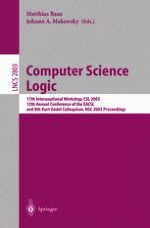2003 | Buch
Computer Science Logic
17th International Workshop CSL 2003, 12th Annual Conference of the EACSL, 8th Kurt Gödel Colloquium, KGC 2003, Vienna, Austria, August 25-30, 2003. Proceedings
herausgegeben von: Matthias Baaz, Johann A. Makowsky
Verlag: Springer Berlin Heidelberg
Buchreihe : Lecture Notes in Computer Science
Enthalten in: Professional Book Archive
